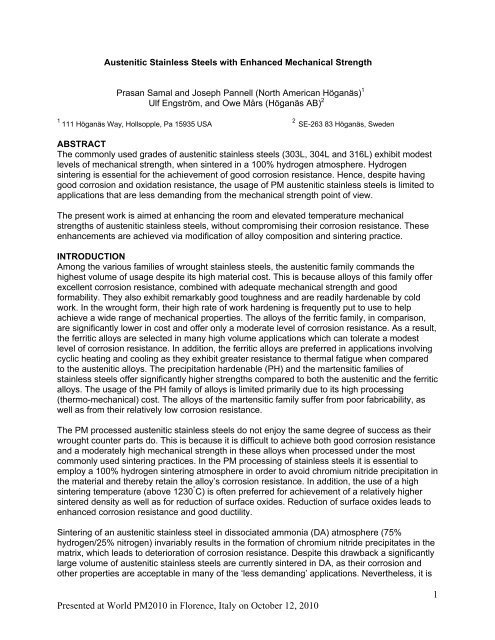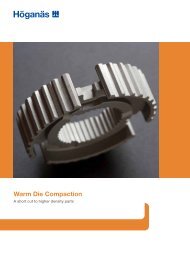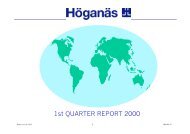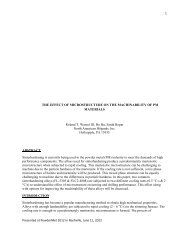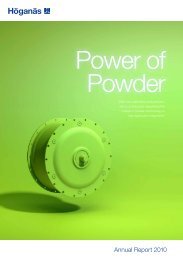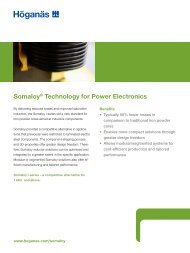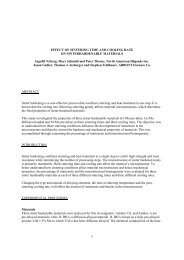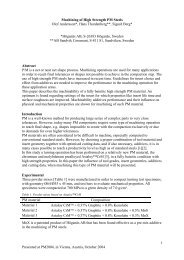Read article - Höganäs AB
Read article - Höganäs AB
Read article - Höganäs AB
- TAGS
- article
- www.hoganas.com
You also want an ePaper? Increase the reach of your titles
YUMPU automatically turns print PDFs into web optimized ePapers that Google loves.
Austenitic Stainless Steels with Enhanced Mechanical Strength<br />
Prasan Samal and Joseph Pannell (North American <strong>Höganäs</strong>) 1<br />
Ulf Engström, and Owe Mårs (<strong>Höganäs</strong> <strong>AB</strong>) 2<br />
1 111 <strong>Höganäs</strong> Way, Hollsopple, Pa 15935 USA 2 SE-263 83 <strong>Höganäs</strong>, Sweden<br />
<strong>AB</strong>STRACT<br />
The commonly used grades of austenitic stainless steels (303L, 304L and 316L) exhibit modest<br />
levels of mechanical strength, when sintered in a 100% hydrogen atmosphere. Hydrogen<br />
sintering is essential for the achievement of good corrosion resistance. Hence, despite having<br />
good corrosion and oxidation resistance, the usage of PM austenitic stainless steels is limited to<br />
applications that are less demanding from the mechanical strength point of view.<br />
The present work is aimed at enhancing the room and elevated temperature mechanical<br />
strengths of austenitic stainless steels, without compromising their corrosion resistance. These<br />
enhancements are achieved via modification of alloy composition and sintering practice.<br />
INTRODUCTION<br />
Among the various families of wrought stainless steels, the austenitic family commands the<br />
highest volume of usage despite its high material cost. This is because alloys of this family offer<br />
excellent corrosion resistance, combined with adequate mechanical strength and good<br />
formability. They also exhibit remarkably good toughness and are readily hardenable by cold<br />
work. In the wrought form, their high rate of work hardening is frequently put to use to help<br />
achieve a wide range of mechanical properties. The alloys of the ferritic family, in comparison,<br />
are significantly lower in cost and offer only a moderate level of corrosion resistance. As a result,<br />
the ferritic alloys are selected in many high volume applications which can tolerate a modest<br />
level of corrosion resistance. In addition, the ferritic alloys are preferred in applications involving<br />
cyclic heating and cooling as they exhibit greater resistance to thermal fatigue when compared<br />
to the austenitic alloys. The precipitation hardenable (PH) and the martensitic families of<br />
stainless steels offer significantly higher strengths compared to both the austenitic and the ferritic<br />
alloys. The usage of the PH family of alloys is limited primarily due to its high processing<br />
(thermo-mechanical) cost. The alloys of the martensitic family suffer from poor fabricability, as<br />
well as from their relatively low corrosion resistance.<br />
The PM processed austenitic stainless steels do not enjoy the same degree of success as their<br />
wrought counter parts do. This is because it is difficult to achieve both good corrosion resistance<br />
and a moderately high mechanical strength in these alloys when processed under the most<br />
commonly used sintering practices. In the PM processing of stainless steels it is essential to<br />
employ a 100% hydrogen sintering atmosphere in order to avoid chromium nitride precipitation in<br />
the material and thereby retain the alloy’s corrosion resistance. In addition, the use of a high<br />
sintering temperature (above 1230 ° C) is often preferred for achievement of a relatively higher<br />
sintered density as well as for reduction of surface oxides. Reduction of surface oxides leads to<br />
enhanced corrosion resistance and good ductility.<br />
Sintering of an austenitic stainless steel in dissociated ammonia (DA) atmosphere (75%<br />
hydrogen/25% nitrogen) invariably results in the formation of chromium nitride precipitates in the<br />
matrix, which leads to deterioration of corrosion resistance. Despite this drawback a significantly<br />
large volume of austenitic stainless steels are currently sintered in DA, as their corrosion and<br />
other properties are acceptable in many of the ‘less demanding’ applications. Nevertheless, it is<br />
Presented at World PM2010 in Florence, Italy on October 12, 2010<br />
1
imperative that in order to open up more applications for PM austenitic stainless steels these<br />
materials do need to combine high mechanical strength with good corrosion resistance.<br />
Strengthening by cold work is not an option in PM. In consideration of this, one needs to look for<br />
other means to enhance mechanical strength. These may include:<br />
(a) Solid solution strengthening by substitutional alloying elements<br />
(b) Solid solution strengthening by interstitial alloying elements<br />
(c) Dispersion strengthening via introduction of sub-microscopic hard phase p<strong>article</strong>s<br />
(d) Matrix reinforcement by introduction of hard p<strong>article</strong>s or fibers<br />
(e) Grain refinement<br />
This work examines the effectiveness of three of the above options (a, b, and d) in enhancing<br />
mechanical strength of PM austenitic stainless steels.<br />
Two alloys were used in this study. One of these was 316L, which is a highly popular grade of<br />
austenitic PM stainless steel and the other alloy was 310L, which contains higher levels of Cr<br />
and Ni than 316L. The latter was selected as the test alloy for the determination of the effects of<br />
alloy composition (solid solution strengthening) on the mechanical properties. Alloy 310L is a<br />
well established wrought austenitic alloy which offers superior oxidation resistance combined<br />
with relatively high elevated temperature strength. Although 310L contains higher amounts of Cr<br />
and Ni compared to 316L, in the powder form of the alloy does offer adequate compressibility<br />
and consequently is suitable for PM processing. The 100% hydrogen sintered 316L was<br />
considered to be the ‘reference’ material.<br />
In the wrought processing of austenitic stainless steels, it is possible to enhance the mechanical<br />
strength of the alloy by injecting nitrogen into the molten metal prior to ingot casting. Presence of<br />
nitrogen atoms at interstitial sites in the matrix leads to strengthening of the alloy. In PM<br />
processing this approach can be utilized only in limited way, since it requires extra care to<br />
prevent chromium nitride precipitation in the matrix during sintering. Avoidance of chromium<br />
nitride precipitation requires careful control of the amount of nitrogen absorbed during sintering,<br />
as well as the employment of rapid cooling following sintering to suppress nitride precipitation.<br />
Effect of matrix reinforcement was investigated by admixing with a hard alloy powder. HB 400<br />
alloy powder was used as the reinforcement agent. This concept has been investigated earlier<br />
by other researchers for improvement of wear resistance of 316L [1]. However, no mechanical<br />
properties data are available in the literature for this composite material.<br />
Fatigue strength of an alloy is a critical material property for components subjected to cyclic<br />
loading. Unlike wrought steels, it is not easy to predict fatigue strength of PM steels based on<br />
static mechanical properties. This study includes a comparative evaluation of fatigue<br />
performance of PM 316L and PM 310L sintered in 100% hydrogen.<br />
MATERIALS<br />
Stainless steel 316L and 310L powders were used in this study. Both powders were nominally<br />
minus 149 microns in p<strong>article</strong> size, and were produced by water atomization using commercial<br />
production equipment at North American Hoganas. Chemical compositions and physical<br />
properties of the powders are listed in Table 1.<br />
Tests aimed at evaluating the effect of a hard phase additive utilized HB 400 gas atomized<br />
powder. The additive amount was 20% by mass. The nominal p<strong>article</strong> size range of HB 400<br />
powder was 15 to 45 microns and its apparent density was 4.74 g/cm 3 . It comprised of 29.7%<br />
Mo, 9.8% Cr, 2.75% Si, 1.0% Ni, 0.75% Fe, 0.02% C, and balance Co.<br />
Presented at World PM2010 in Florence, Italy on October 12, 2010<br />
2
Alloy Cr Ni Mo C Si Mn P S O N<br />
A D<br />
g/cm 3<br />
Plane four point bending displacement controlled fatigue tests were performed using fully<br />
reversed load ratio (R = -1) at 25 – 30 Hz. Before testing the corners of the test bars were<br />
carefully ground to remove burr. The load determinations were based on the staircase method,<br />
per MPIF Standard 56, with a run out limit of 2 million cycles. Fatigue survival limits for 50% and<br />
90% probability (σ50 and σ90) and respective standard deviations (s) were determined.<br />
Figure 1. Modified ISO 3928 Fatigue test specimen with chamfered edges<br />
RESULTS AND DISCUSSION<br />
(1) Static Mechanical Properties<br />
The room temperature mechanical strength, ductility, and hardness results are presented in<br />
Table 2, along with the interstitial contents of the tested samples. Figure 2 is a plot of yield<br />
strength as a function of the nitrogen content of sintering atmosphere. The UTS and yield<br />
strength of 310L are considerably higher than those of 316L for each combination of sintering<br />
atmosphere and HB 400 modification. Typically, 310L samples exhibit 25% higher yield strength<br />
compared to similarly processed 316L. HB 400 modified 316L and 310L show typically 12%<br />
higher yield strength over HB 400-free samples of the same alloy when sintered in 100%<br />
hydrogen. However, no such benefit is seen from HB 400 addition when sintering is carried out<br />
in the 90% hydrogen/10% nitrogen atmosphere.<br />
Microstructures of 100% hydrogen sintered 316L and 310L samples are shown in Figure 3. Both<br />
microstructures show fully austenitic grain structure with well rounded porosity. The grain<br />
interiors and grain boundaries are free of carbides and nitrides.<br />
Alloy Density Sintering<br />
Atmosphere<br />
UTS Y S Elon Hard. Oxygen Nitrogen Carbon<br />
gm/cm 3 % H2/%N2 MPa MPa % HV10 ppm ppm %<br />
316L 7.03 100/0 334 134 20.5 80 860 67 0.021<br />
310L 7.07 100/0 389 183 27.5 94 2363 115 0.018<br />
316L 7.05 90/10 419 239 18.0 106 1859 1475 0.024<br />
310L 7.07 90/10 499 298 19.0 131 3186 2363 0.022<br />
316L 7.04 85/15 431 262 15.0 118 1716 2117 0.020<br />
310L 7.05 85/15 524 328 17.0 138 2912 2844 0.022<br />
316L 7.03 80/20 457 276 16.5 120 1949 2212 0.020<br />
310L 7.05 80/20 532 330 17.0 138 3069 3170 0.023<br />
316L+HB400 7.02 100/0 341 177 14.0 101 1067 22 0.020<br />
310L+HB400 7.07 100/0 365 204 13.5 109 1834 39 0.022<br />
316L+HB400 7.00 90/10 349 237 8.0 113 1766 1311 0.021<br />
310L+HB400 7.02 90/10 441 287 10.0 129 2607 1945 0.023<br />
Table 2. Room temperature mechanical properties and interstitial contents<br />
Presented at World PM2010 in Florence, Italy on October 12, 2010<br />
4
Figure 2. Room temperature Y.S. as a function of N2 content of sintering atmosphere<br />
The 100% hydrogen sintered samples from both alloys contained very small amounts of residual<br />
nitrogen. Hence, the higher yield strength and U T S of 310L sintered in 100% hydrogen over<br />
similarly processed 316L can be attributed entirely to solid solution strengthening from the 50%<br />
higher chromium present in the alloy. It has been reported in literature that Ni does not contribute<br />
to solid solution strengthening in stainless steels [3].<br />
As expected the hydrogen/nitrogen mixed gas sintered samples contained significant amounts of<br />
nitrogen. Also, the residual nitrogen contents in the two alloys increased with the nitrogen<br />
content of the sintering atmosphere. The 310L samples absorbed greater amounts of nitrogen<br />
compared to the 316L samples. This can be attributed to the higher chromium content in the<br />
310L alloy. Significant strengthening is seen in both steels from alloying with nitrogen. However,<br />
it is important to keep in mind that the nitrogen content should not be so high that it results in the<br />
formation of chromium nitrides in the alloy matrix during cooling. If chromium nitride formation<br />
occurs in the sintered stainless steel, chromium will be depleated from the matrix and corroision<br />
resistance of the material will deteriorate. Chromium nitride formation is also influenced by the<br />
cooling rate (from the sintering temperature to about 800 ° C); a rapid cooling rate supresses<br />
chromium nitride formation and also minimizes any additional nitrogen absorption at intermediate<br />
temperatues. Several researchers have determined, for specific cooling rates, the critical<br />
nitrogen level necessary for avaoidance of chromium nitride formation in 316L. (Although no<br />
such data is available in the literature for 310L, the solubility limit of nitrogen in 310L is expected<br />
to be higher than that of 316L due to its higher Cr content, and the critical nitrogen level is also<br />
expected to be somewhat higher.) Frisk et al. have determined the critical nitrogen content for<br />
316L to be 4000 ppm for a cooling rate of 1.0 ° C/sec [4]. Zitter et al. have indicated that corrosion<br />
resistance of 316L is unaffected if the nitrogen content is less than 3000 ppm [5]. Samal et al.<br />
have reported deterioration of corrosion resistance of 316L when nitrogen content was 2400<br />
ppm. for a cooling rate of 1.1 ° C/sec [6]. Based on these data, it can be said that the use of a<br />
90% hydrogen/10% nitrogen sintering atmosphere is definitely safe for both alloys under most<br />
normal sintering conditions. Considering this, the combined effect of selecting 310L and utilizing<br />
a 90% hydrogen/10% nitrogen leads to a two fold increase in yield strength over that of a 100%<br />
hydrogen sintered 316L. The 85% hydrogen/15% nitrogen sintering atmosphere is considered<br />
safe to use only for 316L. The use of 80% hydrogen/20% nitrogen atmosphere is not<br />
recommended for either alloy. Relative enhancements in the mechanical strength become<br />
smaller and smaller as the amount of nitrogen in the sintering atmosphere beyond 10%.<br />
Presented at World PM2010 in Florence, Italy on October 12, 2010<br />
5
Figure 3. Etched microstructures of 310L (left) and 316L (right)<br />
Table 3 and Figure 4 present the elevated temperature mechanical properties of 316L, 310L,<br />
and the HB 400 modified versions the alloys sintered in 100% hydrogen and 90% hydrogen/10%<br />
nitrogen atmospheres. In 100% hydrogen sintering 310L shows approximately 10% higher yield<br />
strength over similarly processed 316L. In the 90% hydrogen/10% nitrogen sintering 310L<br />
samples typically shows 25% higher yield strength over their 316L counterparts. HB 400<br />
modification enhances mechanical strength under both sintering atmospheres and for both<br />
alloys. Hence, enhancements in the elevated temperature yield strength can be achieved by all<br />
three means - solidsolution strengthening, nitrogen alloying and hard phase addition.<br />
Alloy Density Sintering<br />
Atmosphere<br />
UTS Y S Elon. Oxygen Nitrogen Carbon<br />
gm/cm 3 % H2/%N2 MPa MPa % ppm ppm %<br />
316L 7.05 100/0 187 84 10.5 860 67 0.021<br />
310L 7.06 100/0 192 92 12.5 2363 115 0.018<br />
316L 7.03 90/10 229 124 8.5 1859 1475 0.024<br />
310L 7.03 90/10 244 157 9.0 3186 2363 0.022<br />
316L+HB400 7.04 100/0 200 118 9.0 1067 22 0.020<br />
310L+HB400 7.04 100/0 242 128 9.0 1834 39 0.022<br />
316L+HB400 7.00 90/10 207 143 5.0 1766 1311 0.021<br />
310L+HB400 7.00 90/10 232 188 13.0 2607 1945 0.023<br />
Table 3. Elevated temperature (650 0 C) mechanical properties and interstitial contents<br />
HB 400 modification of these two austenitic stainless steels may be characterized as noncontinuous<br />
reinforcement of their matrices by the hard p<strong>article</strong>s, similar to that of a metal matrix<br />
composite (MMC). SEM examination of the fracture surfaces of the HB 400 modified 310L<br />
sample showed that there was no de-cohesion at the hard p<strong>article</strong>/matrix interface; and that the<br />
HB 400 p<strong>article</strong>s had undergone fracture along with the matrix. SEM/EDS analyses of the<br />
fracture surface of HB 400 p<strong>article</strong>s also indicated that a modest amount of chromium had<br />
diffused into the HB 400 p<strong>article</strong>s during sintering. These observations indicate that there was a<br />
limited degree of sinter bonding between the matrix and the HB 400 p<strong>article</strong>s, and this may<br />
account for the minimal reduction in ductility compared to the HB 400-free materials, at both<br />
room and elevated temperatures.<br />
Presented at World PM2010 in Florence, Italy on October 12, 2010<br />
6
Figure 4. Elevated temperature Y.S. as a function of N2 content of sintering atmosphere<br />
(2) Fatigue Properties<br />
The results of the fatigue testing are presented in Table 4 and the corrsponding SN-curves are<br />
shown in Figure 5. The fatigue limits with 50% and 90% survival rates are denoted as σ50 and<br />
σ90, respectively. The measured standard deviation is denoted as ‘s’. It is noted that fatigue limit<br />
of 310L is around 8% higher than that of 316L. In both cases the scatter in the data is small.<br />
As seen in Fig. 5, both materials have several failed specimens between 10 6 and 2x10 6 cycles.<br />
This means that it is unclear if a plateau in the SN-curve has been reached and the run out limit<br />
should be set higher than 2x10 6 cycles to verify the measured fatigue limit. This was not possible<br />
for practical reasons and the results must therefore be used with some caution.<br />
The fatigue properties obtained here translate to fatigue endurance ratios (F.E.R.) of 0.36 for<br />
310L and 0.40 for 316L. This is based on mean fatigue life (σ50). Using the same criteria (σ50),<br />
Sanderow et al. had determined the F.E.R. of 6.90 g/cm 3 density, nitrogen free 316L to be<br />
approximately 0.34. Their study was based on rotating beam fatigue testing of machined impact<br />
bar specimens [2].<br />
Material �50<br />
[MPa]<br />
s<br />
[MPa]<br />
�90<br />
[MPa]<br />
310L 144
Stress Amplitude [MPa]<br />
250<br />
200<br />
150<br />
a.<br />
100<br />
50<br />
0<br />
Broken<br />
Run Out<br />
Run Out line<br />
10 000 100 000 1 000 000 10 000 000<br />
N [cycles]<br />
Figure 5. SN-curves for 310L (a) and 316L (b)<br />
CONCLUSIONS<br />
1. Significant strengthening can be achieved in both 316L and 310L by sintering in a 90%<br />
hydrogen/10% nitrogen atmosphere, when compared to 100% hydrogen atmosphere.<br />
2. Use of 310L in the place of 316L can provide higher room and elevated temperature<br />
mechanical strengths, for both 100% hydrogen and 90% hydrogen/10% nitrogen, sintering<br />
atmospheres.<br />
3. Alloy 310L offers 8% higher fatigue strength compared to 316L for the 100% hydrogen<br />
atmosphere sintering.<br />
4. Admixing of HB 400 powder to 316L and 310L does lead to enhancements of their<br />
mechanical strengths at both room and elevated temperatures (650°C), with minimal<br />
reduction in ductility.<br />
ACKNOWLEGEMENT<br />
The authors would like to thank Mr. Michael Andersson for carrying out the fatigue tests.<br />
REFERENCES<br />
1 H. Sanderow, “Stainless Steel P/M Alloys – Unique Applications”, in New Perspectives in<br />
Powder Metallurgy, vol. 9, MPIF, Princeton, NJ, 1990, p. 39 to 54.<br />
2 H. Sanderow, J. R. Spirko, and T.G. Friedhoff, “Influence of Density, Sintering Conditions and<br />
Microstructure on the Fatigue Properties of PM Stainless Steels”, Advances in Powder<br />
Metallurgy and Particulate Materials, ed. C. Rose and M. Thibodeau, vol. 9, MPIF, Princeton,<br />
NJ, 1999, p. 9-105 to 9-117.<br />
3 D. Peckner and I. M. Bernstein, Handbook of Stainless Steels, McGraw-Hill Publication, New<br />
York, 1977, p. 4-19.<br />
4 K. Frisk, A. Johansson, and C. Lindberg, “Nitrogen Pick Up During Sintering of Stainless<br />
Steel”, Advances in Powder Metallurgy and Particulate Materials, ed. J. Capus and R. M.<br />
German, vol. 3, MPIF Princeton, NJ 1992, p. 167 to 181.<br />
5 H. Zitter and L. Habel, “Zur Loslichkeit des Sickstoff in Reineisen und austenitischen Chrome-<br />
Nickel-Stahlen”, (On the Solubility of Nitrogen in Pure Iron and Austenitic Chromium-Nickel<br />
Steels), Arch. Eisenhuttenwes., vol. 44 (no 3), 1973, p. 181 to 188.<br />
6 P. K. Samal, J. B. Terrell, and E. Klar, “Effect of Sintering Atmosphere on the Corrosion<br />
Resistance and Mechanical Properties of Austenitic Stainless Steels – Part II”, Advances in<br />
Powder Metallurgy and Particulate Materials, vol. 7, ed. W. Eisen and S. Kassam, MPIF,<br />
Princeton, NJ, 2001. p. 7-135 to 7-141.<br />
Presented at World PM2010 in Florence, Italy on October 12, 2010<br />
Stress Amplitude [MPa]<br />
250<br />
200<br />
150<br />
b.<br />
100<br />
50<br />
0<br />
Broken<br />
Run Out<br />
Run Out line<br />
10 000 100 000 1 000 000 10 000 000<br />
N [cycles]<br />
8


